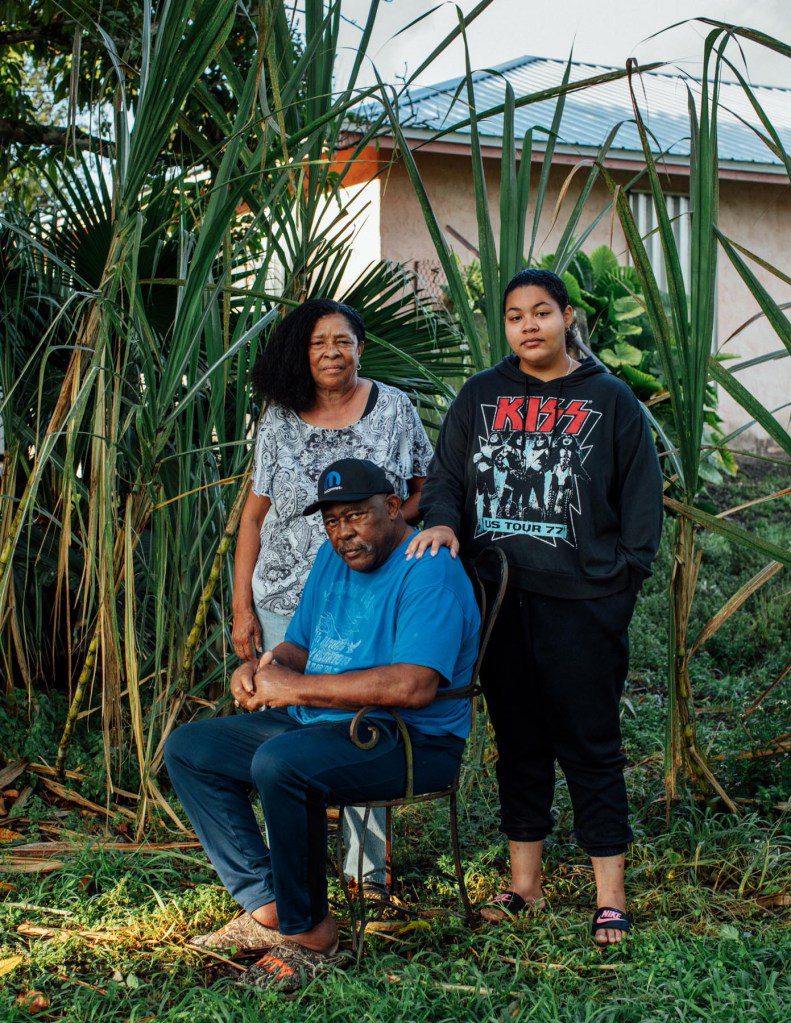A Fire in the River: Big Sugar and ‘Black Snow’ in the Everglades
A
long the rim of Lake Okeechobee, the seasons aren’t marked by temperature or falling leaves but by the humidity, light, and plumes of ash that blanket this part of Florida come October. Just as the air dries, the wind turns east and sugar-cane farmers set to harvesting stalks of cane across half a million acres in Florida, but before the stalks are cut, growers set their crops on fire. Burning is an easy way to eliminate the outer leaves of sugar cane and reduce costs. Every year from October until May, sometimes until June, the smoke haunts residents. Some claim it’s killing them. Others write it off as a seasonal nuisance. But all of the residents in towns strung along the lake’s southern edge know the resulting ash as black snow.
Driving through the small city of Pahokee, Ed Jones pointed out the window. “This is my home here,” he said. There’s the former Prince Theater, a beautiful but shuddered pink, art deco tomb. There’s the break of sugar cane where Ed ran rabbits as a kid. There’s the set of acres where he picked sweet corn, peas, and cabbages for decades. The fresh rows of black muck where he planted sugar cane each year. The packing houses, the mills he drove trucks to and from. The school where his granddaughter goes each day. The apartments he grew up in, one in Belle Glade where all the tenants shared a single bathroom. And hanging in the air as Jones ran through his life here, there was the acrid scent of burning sugar cane. He looked around at the edge of Belle Glade and said, “This is our town.”
The more that Jones spoke, the weaker his voice grew. “I hate to say it, but it’s awful,” he said. “In the 70 years I’ve been here, it’s changed for the worse, simply because they’ve opened more sugar mills. Farmers grow more cane, and there’s more soot. It’s that simple.” Columns of smoke dotted the horizon. Soon, the smoke passed over the towns. The dim light resembled an eclipse.
For a century, sugar has grown here along the edge of Lake Okeechobee, becoming the state’s third-largest source of agricultural revenue, according to the USDA, and making up more than half of America’s domestic production. Sugar animates this part of Florida, which locals call “the Glades,” where the economy relies almost solely on the industry. But a history of labor abuses, lawsuits aimed at growers, and the practice of burning that, according to a study, poses a health risk strains the relationship between many of the residents of the Glades and the sugar industry.
Compounding the story, the industry’s foothold in the center of the historic Everglades that begins north of Lake Okeechobee and stretches south to the Gulf of Mexico makes it a principal impediment to Everglades restoration. Water that once flowed south from the lake through the Everglades and into the Gulf was diverted into thousands of canals to dry the land for farming. In turn, the effort not only remade the Everglades but remade ways of life for the Seminole and Miccosukee tribes who have lived there for centuries. It irrevocably altered the landscape to suit the agricultural interests and, in some cases, what’s become colloquially known as “Big Sugar,” a consortium of two companies and a farmer’s cooperative.
Today, Florida’s sugar growers generate $3.4 billion annually, with more than 14,000 jobs in the state, according to the University of Florida. In just a century, it’s grown from a nascent crop into a peerless one.
As we walked together, Ed Jones told me why this stretch of land will always remain central to his life. His story began 72 years ago, when his mother, a migrant farmworker, followed the summer harvest north to New Jersey, then headed south to work around Belle Glade until the summer harvest drew farmworkers back north.
By high school, Jones left social studies for the fields, following the same route his mother once did each year. In 1984, while picking sweet corn in Georgia, he met Debra at a family party. A year later, she moved with him to Belle Glade, and she remembered asking, “What is this stuff falling out the sky?”
“They burning cane,” they told her as ash coated the city in a gray film. For the past 38 years, she composed her calendar around the smoke. Periodically, the house needed to be pressure-washed, the cars cleaned, air filters replaced. Immediately, Debra’s allergies flared up. By Christmas, she learned how to use a nebulizer. In January, she needed an inhaler. “What have I gotten myself into?” she thought.
Ed Jones, his wife, Debra, and their granddaughter Madison.
Rose Marie Cromwell
If there was any thread of solidarity in the Glades, based upon dozens of interviews, it’s that many residents suffer from respiratory illnesses, some turning to a nebulizer three times every day. Many believe that the smoke either caused or exacerbated their symptoms. U.S. Sugar began publishing an annual “State of Our Air” report in 2020, dispelling the connection between the smoke and residents’ health. And when we asked the company, it pointed to county-health rankings for air quality as well as a 2013 study by the Florida Department of Health regarding asthma. According to the company, the air was some of the “best … in the state,” and met all ambient air-quality standards.
In Pahokee, Jones felt there was nothing to show for a hundred years of growing cane, only a moribund town where most residents drove 40 minutes to shop at Walmarts in Clewiston, West Palm Beach, or Okeechobee. “We don’t have nothing, nothing for the kids aside from football and baseball,” he said. “That’s what hurts me about Madison being raised in this area,” Debra added of their granddaughter.
“There’s no telling how many people around here got breathing conditions,” Debra said. “But they never complain, because they need to work.” And then softly, she said, “This is an agricultural town. I have to look at it this way: If they close the sugar mills, a lot of people will have no income.”
Despite the omnipresence of sugar in the Glades, unemployment in the three counties where sugar predominantly grows remains among the highest in the state. And out of the roughly 40,000 residents that live among six towns in the Florida sugar belt, almost a third live in poverty, triple the national average. After residents in eastern Palm Beach County organized in 1991, the Florida Department of Agriculture outlawed the burning of sugar cane when the winds were west and carried smoke from the Glades toward the more affluent areas of Palm Beach County. Today, burns only occur when the winds are east, heading toward Pahokee, Belle Glade, and South Bay, towns that are overwhelmingly Black and Hispanic.
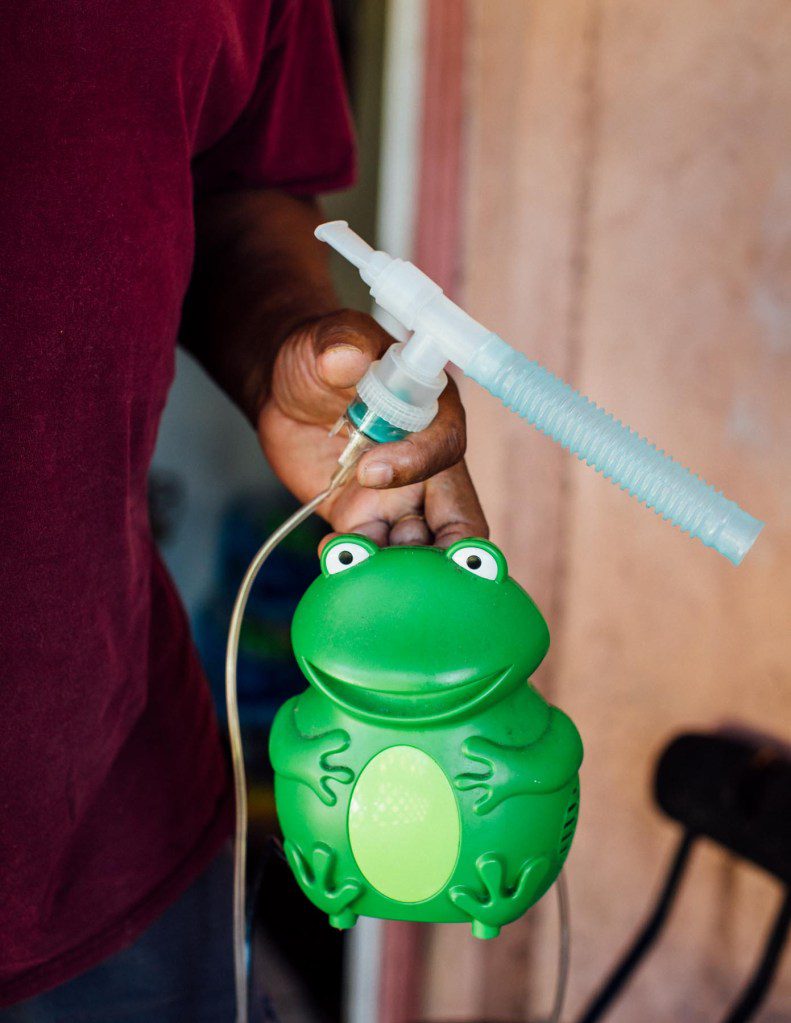
Ed Jones holds the nebulizer used by his teenage granddaughter. His whole family deals with respiratory issues while living close to burning cane in Pahokee, Florida.
Rose Marie Cromwell
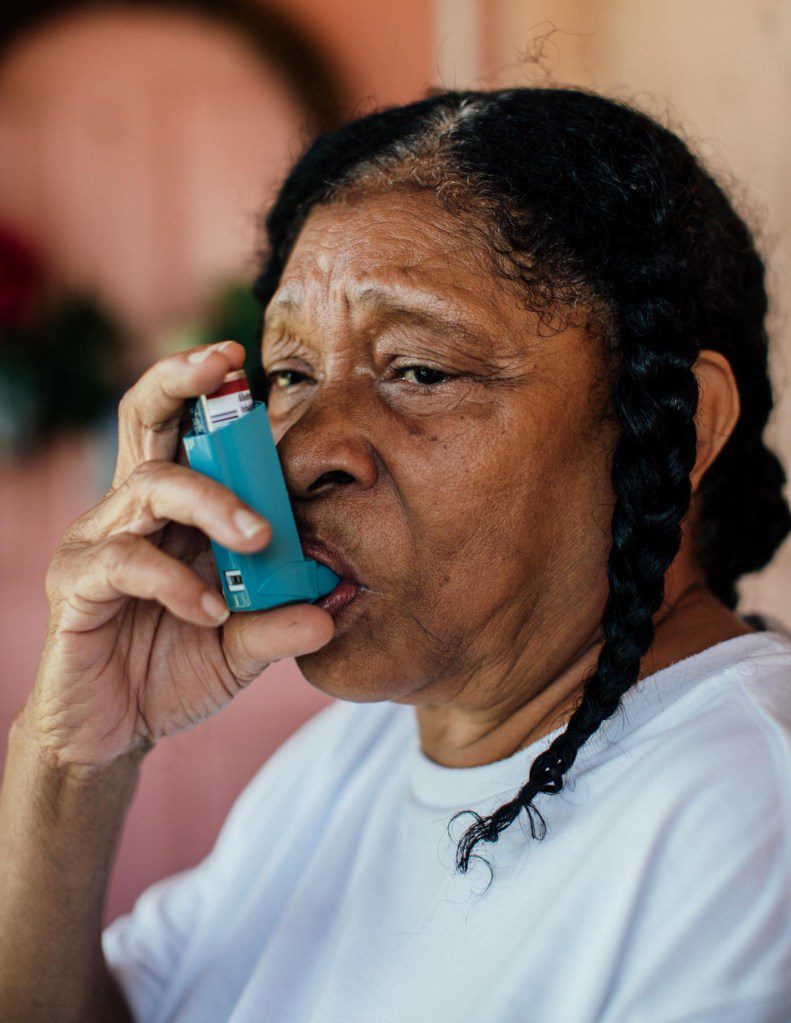
Debra Jones, like the rest of her family, suffers from asthma. When she first saw the black snow from the burn she remembered asking, “What is this stuff falling from the sky?”
Rose Marie Cromwell

In 2021, The Palm Beach Post and ProPublica published a series of investigations that revealed how little the state’s health departments had done to monitor the effect of particulate matter — an airborne pollutant linked to a long list of respiratory and cardiac symptoms as well as cancer — produced by the burns in the Glades. In what amounts to a swath of land roughly as big as Rhode Island, there is a single air monitor managed by the Florida Department of Environmental Protection. But for years, the monitor malfunctioned. It also used 24-hour averages to measure the amount of particulate matter in the air, sometimes obscuring the risk posed by smoke during pre-harvest burns. When asked about its harvest, U.S. Sugar, the largest grower of cane sugar in America, told Rolling Stone in an email, “The people of U.S. Sugar stand firmly behind the integrity and safety of our farming practices; just like many of our fellow farmers who live and work on their family farms — we live here, we work here and raise our families here in these rural farming communities.” In another document, U.S. Sugar claimed that “ash from burnt sugar cane is not a health risk.”
However, in 2022, a study led by researchers at Florida State University and supported by NASA confirmed that smoke in the Glades contributed to premature deaths. Still, U.S. Sugar defends the practice of burning the crop as “safe.”
And then, in 2023, Winrock International, a nonprofit devoted to agricultural issues, published a study that sugar-cane growers in the Glades accounted for more than 7.3 million metric tons of greenhouse-gas emissions each year — the same amount as 1.6 million cars. What was surprising is that more than 80 percent of those emissions were due to soil oxidation, while burning made up less than two percent. It placed Florida’s sugar growers among the top 100 greenhouse-gas polluters in America. In a statement from Florida Crystals, representatives pointed to its status as the largest Regenerative Organic Certified farmland in America, outlining their goal to “increase carbon capture and store it.” Ultimately, they said, they meant to “ensure our farms can supply safe, U.S.-grown foods for generations to come.”
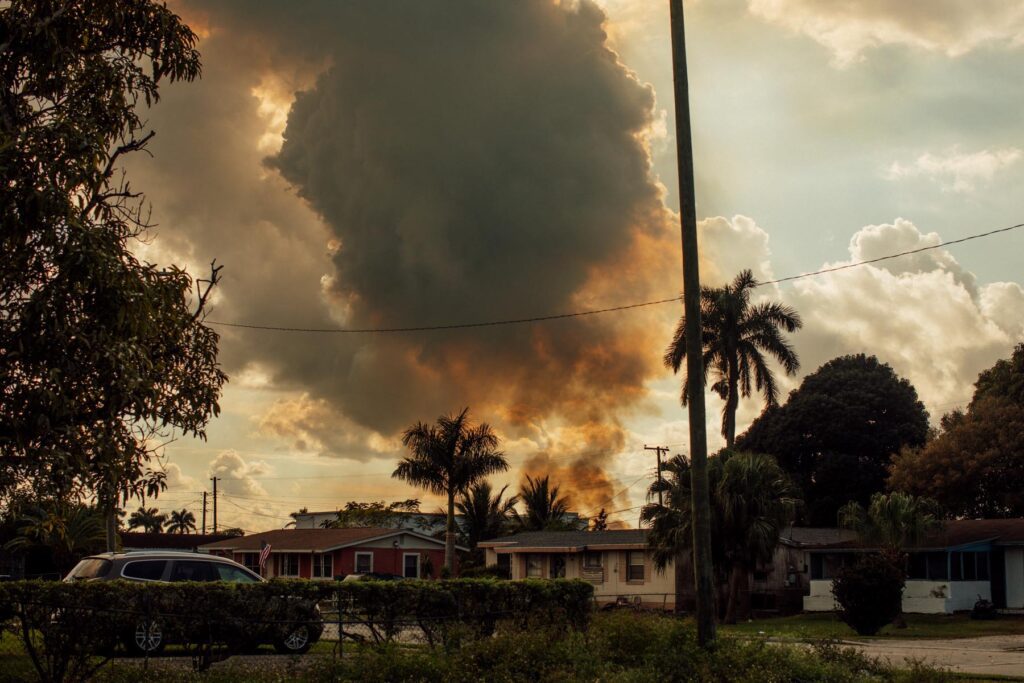
Smoke from the burning of the sugarcane harvest lingers over homes.
Rose Marie Cromwell
Among the dozens of residents we spoke with while reporting over the past two years, many felt there was no means to sway the sugar industry to harvest their crop without burning it, a practice known as green harvesting that’s already taking place in sensitive sites near schools, hospitals, and major roads. But in other countries, like Brazil, which produces 20 times as much sugar, they’ve eliminated burning almost entirely after public pressure mounted. When U.S. Sugar was asked about a shift to green harvesting by The Palm Beach Post, the company acknowledged it would mean a “significant economic impact,” but declined to offer details. In a written response to Rolling Stone, U.S. Sugar said that “dealing with sugar cane growing and harvesting conditions is not a ‘one-size-fits-all’ proposition,” before outlining how central the process was to the region and success of its annual harvest. In the case of Florida Crystals, a source from the company noted how it already employs green harvesting in some cases, uses biomass to power mills, and even manufactures packaging with it.
Back on Ed Jones’ porch in Pahokee, he showed me a green nebulizer shaped like a frog — his granddaughter’s. Out front, a sign planted in the ground read, “A Pahokee High Honor Student Lives Here.” In the following days, the humidity dropped. East winds blew into the Glades just as thousands of acres of sugar cane burned. The smoke drew across the center of Florida like a sheet, and the Jones family could no longer sit on the porch. Ed Jones bent forward, his head dropping between his shoulders, and asked, “What can I do against a big corporation?”
SUGAR ROSE AS the Glades’ North Star over the past century, when America’s sweet tooth and a storm galvanized the industry’s place here. At the back end of the 1920s, two hurricanes lashed Florida; the latter one killed more than 2,500 people living along Lake Okeechobee’s southern rim in 1928. In the storm’s wake, the U.S. Army Corps of Engineers encased the lake with a 40-foot-tall dike, drastically altering the ecology of South Florida. In the next century, engineering projects would move enough earth to erect a mountain in the Everglades, and made large-scale farming possible.
By 1931, Charles Stewart Mott bought the bones of the Southern Sugar Corp. after it went bankrupt. He renamed the company the United States Sugar Corp. In 1948, Congress carved out the Everglades Agricultural Area (EAA) south of the lake, giving the industry a permanent home in the Everglades one year after the Everglades National Park opened. And then a decade later, Alfonso and Jose Fanjul fled Fidel Castro’s Cuba when rebels nationalized their family’s home, their land, and took all that belonged to them, including 150,000 acres and 10 mills. In 1959, Alfonso Fanjul Sr. bought 4,000 acres in the EAA, built a mill along the lake, and began to reassemble what they’d lost. That same year, America incentivized sugar growers, embargoing imports from Cuba, and the industry took shape.
Today, there are three threads that make up Florida’s sugar industry. The first is U.S. Sugar, the company that Mott resurrected. Collectively, U.S. Sugar owns more than 245,000 acres in Florida. The second is Florida Crystals, the company that the Fanjuls built. As of this year, they own 190,000 acres in Florida, and their parent company has a minority stake in a company that owns 240,000 in the Dominican Republic, as well as refineries and mills in four states and seven countries that belong to a subsidiary, ASR Group (American Sugar Refining). The third thread is composed of the Sugar Cane Growers Cooperative of Florida, which farms 73,000 acres, belongs to 43 growers, and sells its raw sugar to ASR. And despite the limited number of growers, the industry’s power extends well beyond the borders of the Everglades.
During the 2020 election cycle, Big Sugar gave more than $11 million to federal candidates. And between 1994 and 2021, the industry spent more than $65 million in state elections alone. The resources devoted toward lobbying are dizzying, and it’s why Big Sugar has become synonymous with power in Florida and in federal agricultural policy. Its influence largely focuses on two issues. One is galvanizing America’s sugar program into the Farm Bill. The second is retaining its ability to grow sugar in the center of the historic Everglades and continue to burn the crops pre-harvest, which U.S. Sugar deems essential.
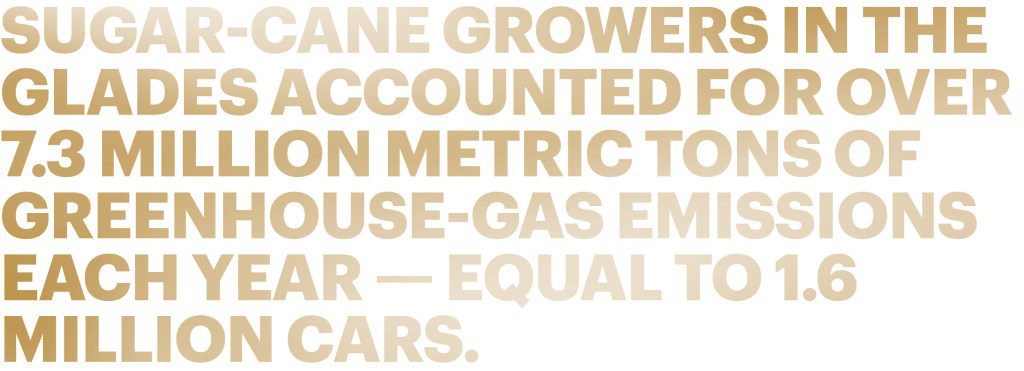
That’s why the story of sugar farming is inextricably bound to the restoration of the Everglades. From the foot of Orlando, the Everglades forms like a finger dipping into the subtropics before stretching across all of South Florida. It begins as a drip in the Kissimmee River Valley and falls south into a series of lakes, then rivers, before it reaches Lake Okeechobee, the 10th-largest lake in the U.S. On the eastern edge, the St. Lucie River carries water into the Atlantic, and along its western rim, the Caloosahatchee into the Gulf. South of those rivers, the Everglades extends from coast to coast, forming a shallow 60-mile-wide and 100-mile-long attenuated river running into Florida Bay. It carves through plains and deep sloughs, and where the land rises by inches, cypress and pond apple swamps grow before reaching flatwoods along the coastal ridges that are home to Naples and Miami.
For centuries, mystery remained central to the Everglades. Initially, cartographers deemed it impenetrable. The Spanish called it “Lake of the Holy Spirit.” Indigenous tribes called it “Pahokee,” meaning grassy water. Later, Marjorie Stoneman Douglas lent it the indelible name “The River of Grass.” In the past century, more than half of the Everglades were developed for agricultural and residential use as Florida’s population grew. And acre by acre, America lost a wilderness the size of Connecticut.
LATE IN THE summer, less than 40 miles west of Miami, a curtain of rain hung to the east as Samuel Tommie pored over a set of maps. He was trying to make it to one of his family’s tree islands set against the edge of the Big Cypress National Preserve south of Florida’s sugar bowl. There are thousands of these family lands floating among the veins of sweet water and saw grass. For centuries they’ve been passed from generation to generation in the Seminole and Miccosukee tribes. Tommie sat in the cab of a purple airboat, filming with a camcorder as his friend carved through the estuarine maze. After nearly 30 minutes, we reached an island hidden behind a wall of tall grass. As we reached the dock, a torrent of rain chased us underneath a chickee not unlike the one Tommie grew up beneath six decades ago.
Raised by his grandparents on a tree island in Shark Valley, an area only 30 miles west of Miami, Tommie came of age in pristine wilderness. But today, at 67, the plants he knew as a kid have vanished. “I don’t see them anymore,” he said. The sky, once punctuated by the silhouettes of birds, is empty. Noises he knew intimately were gone. “Politics is what changed the environment,” he told me. “We’re talking about our ways of life.”

Samuel Tommie spent the first years of his life being raised on an island in the Everglades.
Rose Marie Cromwell
Tommie has collected a lot of names. Often, it’s artist or activist. Sometimes, it’s communist or terrorist, he joked. He was once employed by the tribe in its Environmental Resource Management Department, and later learned the backcountry as an airboat guide. Recently, he’s been returning to many of those places trying to form a record of what the Everglades once was and what it’s become. As he said, “I was born on those islands.”
Those changes were marked first by a century-old campaign to drain the Everglades to create farmland, and then by the engineering projects meant to restore the flow of water south. But as agriculture and residential development throughout the state grew, it was the concentration of nutrients like phosphorus and nitrogen running off fields and lawns north of the lake that exacerbated the decline.
Some places south of the EAA that were once wet year-round were now often dry. Animals and plants central to Seminole culture disappeared. Soon, the tribe’s ability to retain their cultural practices winnowed. “Agriculture to the north dramatically affected the reservation,” said Jessica Cattelino, a Seminole historian at UCLA. “They were vulnerable — with no say and no recourse — to others’ decisions about water.”
For decades, the agricultural industry’s influence on policy persuaded regulators to put water where it wanted when it wanted. They could irrigate their crops when it was dry or back-pump water to keep them from drowning in the wet season. The tree islands were central to Seminole history as the places that helped them survive three wars with America. Now, with the inundation of water and nutrient pollution, tree islands were disappearing due to high water levels, while some parts of the Everglades that were once wet year-round were experiencing drought. “It made a major impact on the natural order of things,” Tommie said. This meant not just a loss of place but the loss of plants critical for ceremonies, less wildlife, and ultimately a loss of identity. As Cattelino told me, “Seminole sovereignty is inextricably tied to the Everglades ecosystem.”
A few weeks earlier, I followed Tommie and Quenton Cypress, who worked for the tribe’s Heritage and Environment Resources Office, into the woods near the Big Cypress Reservation. Bundles of palmetto fell off into tea-colored water. The delicate flowers of yellow top brushed against cones of goldenrod. Stands of slash pine marched toward cypress domes just beginning to turn amber as fall arrived. Like Tommie, Cypress, who grew up on the Big Cypress Reservation, remembers a wilder place. “There used to be way more,” he said. “More trees.” With his three children in mind, he said, “They’re going to inherit a whole different area.… What we had cannot be brought back.”
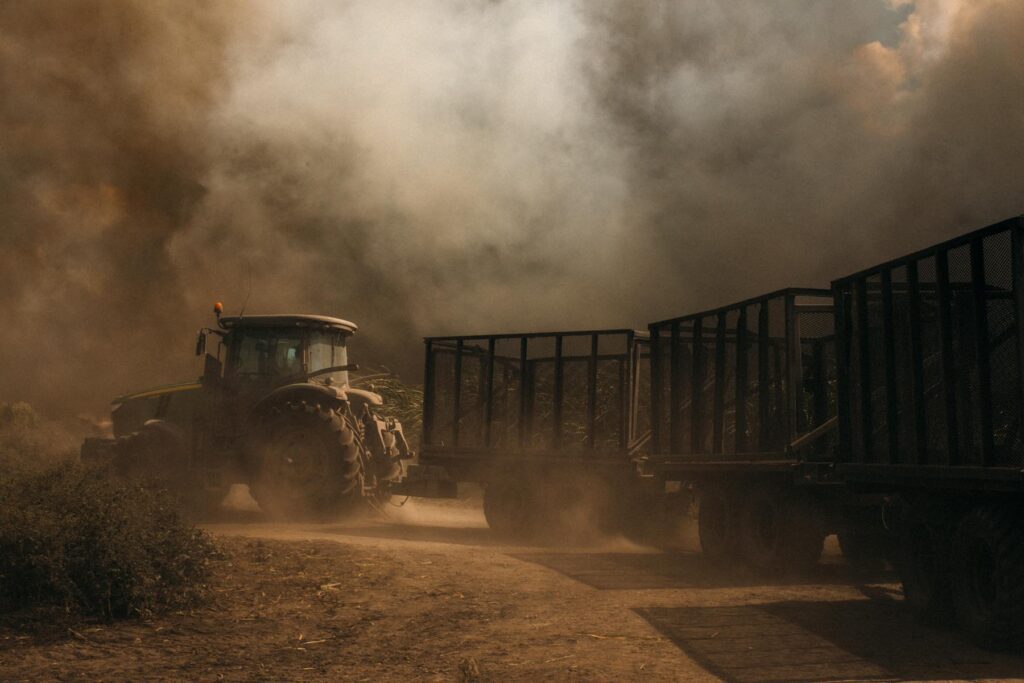
Farmers and locals have to work and live with the smoke from the fields.
Rose Marie Cromwell
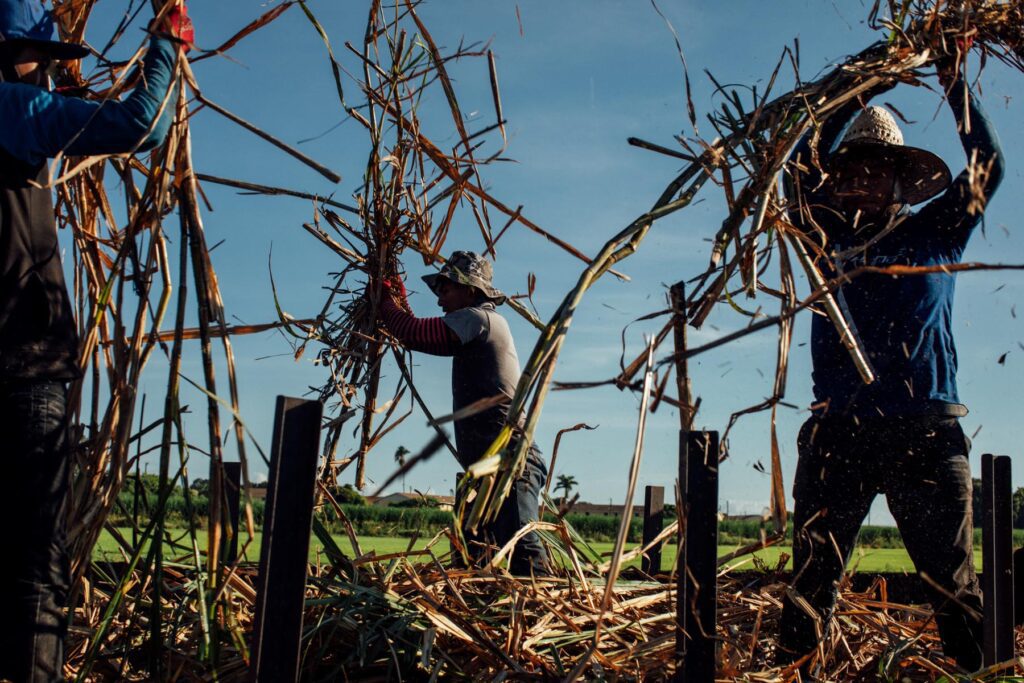
H2A Farmworkers from Guerrero plant sugar cane in a farm owned by RC Hatton farms.
Rose Marie Cromwell
THE SOIL ALONG the border of Lake Okeechobee is a touch past black and known as “muck.” In the autumn light, the contrast between the furrows of muck and the lime oceans of cane glow. Paul Allen, a farmer from Pahokee, looks out over an acre just outside town as a crew of men from Mexico set to planting sugar, tossing canes from the bed of a trailer.
Just like Ed Jones, Paul Allen’s affection for the place runs deep. His father moved to the Glades from Hardee County on the west side of Okeechobee, where he worked in packing houses. In high school, Allen got a job scrubbing celery boxes in the packing houses of South Bay. Later, Allen’s career led him to R.C. Hatton, which grew sweet corn, cabbages, and sugar cane. In 2007, he became a partner in the operation. Today, Hatton owns more than 12,000 acres and a portion of the packing house where Allen scrubbed boxes as a kid.
When Allen started farming, there were probably twice as many farmers. They were folks that understood the slant of light that fell across Florida, the outsize effect of weather in the subtropics, folks who could grow anything. He says the work to him was about feeding the country, and the perception of farmers as complicit in the degradation of the environment and the issue of burning stung. It was a complicated dance between residents alleging that the destruction of the Everglades was due to the influence of the sugar industry without also acknowledging the decades of drainage that preceded the crop or the role population growth played.
Those questions hung over Allen each day as he drove between his office in downtown Pahokee and the fields he tends. Everything he ever had or will have was bound up in this land. For some, the undulating tendrils of cane were a visual metaphor for the destruction of the Everglades, a precursor to the smoke that came each year. For Allen, that crop was what he devoted his life to. “In the beginning,” he said, “it was just a way to provide for my family.”
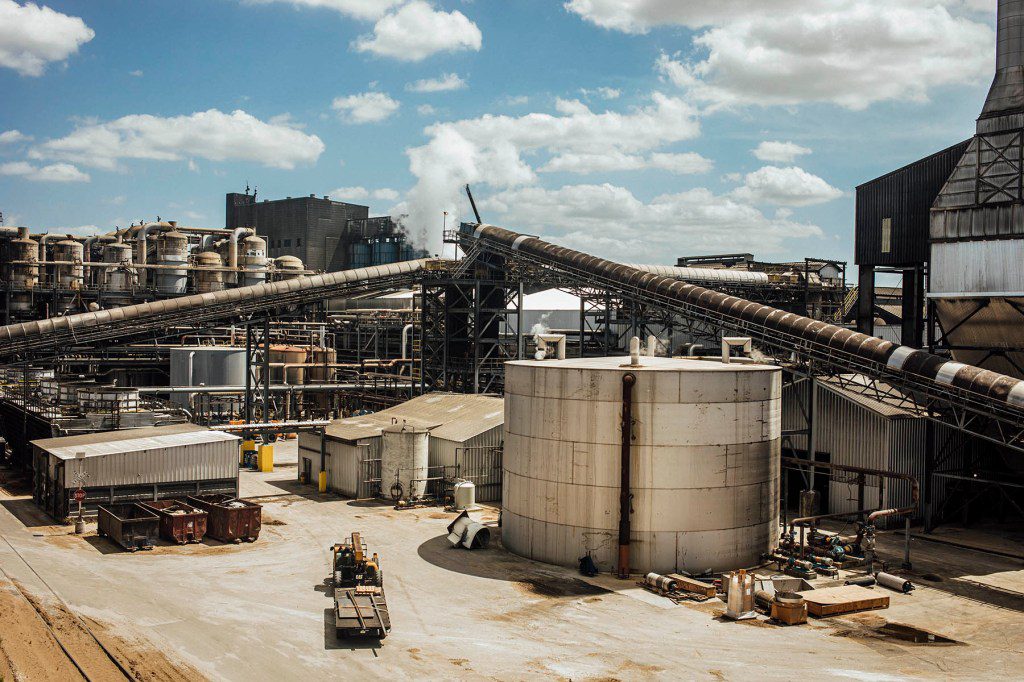
US Sugar Mill in Clewiston, Florida.
Rose Marie Cromwell
In 1914, Hans Stein boarded a barge on the west side of Okeechobee bound for the Glades. He’d sold everything after he got word from a family member about some fertile land south of the lake. He arrived there in a little settlement called Chosen — what predated Belle Glade — and began to place seeds in the ground. Four generations later, his great-grandson, Fritz “Sonny” Stein III, was still farming that same ground, growing sugar cane on less than 1,000 acres.
“It’s not as fun as it used to be,” Stein said. “Put it that way.” As we spoke, he told me about the 360 acres his father once sold to clear debts, the winnowing profit margins, and the five family members they lost to the 1928 hurricane. “Everything just washed away,” he told me. Today, Stein isn’t sure how much longer independent farmers might hang on in the Glades due to the added cost. “All the rules have changed,” he said. “It’s getting tougher for the small guy. America needs to wake up and look at the farmers in a different light. They’re not making land anymore.” In the past two decades, growers had made significant changes in the way they grew and harvested sugar cane. Stein felt the industry could and would adapt to green harvesting. “It’s a whole lot harder to cultivate,” he said. “But that’s going to be our next challenge.”
BENEATH A CHICKEE hut along the Tamiami Trail just east of the Miccosukee Tribe’s reservation, Michael Frank, a tribal elder, led me through a history of the tribe’s relationship to sugar cane and to the state. He remembered when his family stopped eating fish due to the high levels of mercury. He remembered when the tree islands that he grew up on flooded even during the dry season. “Deer are not made to live in aquariums,” he said. “You can blame sugar for the rest of your life,” he added. “They have their part, but you’ve got your part, too.”
In October 1988, Dexter Lehtinen, then the U.S. attorney general for the Southern District of Florida, quietly filed a lawsuit in Miami. It alleged that the state of Florida violated federal water standards and damaged the Everglades National Park by allowing polluted water from farms to flow directly into the park. The lawsuit set limits for harmful nutrients like phosphorus. Without those set limits, environmental scientists believed the southern Everglades would have met a certain and cruel death.
By 1992, Lehtinen became general counsel for the Miccosukee Tribe. (In 2011, it sued him.) Together, they helped reverse decades of water management meant to serve agriculture. Regulators and growers were compelled by the courts to build thousands of acres of water-treatment areas. Ultimately, they established the most stringent water-quality standard in America. In Michael Grunwald’s book The Swamp, he wrote, “The vigilance of the Miccosukees has been responsible for some of this success; the Everglades saved their ancestors, and they have helped to return the favor.”

In 2012, a Miccosukee polymath named Houston Cypress met a friend for a drink in a haunt off LeJeune Road in Miami. That night, Cypress and Jean Sarmiento outlined the Love the Everglades Movement, a nonprofit that guided groups in the Everglades, hosted events, and organized protests. Their idea was straightforward: If people fell in love with the Everglades, they might try to protect it. Cypress echoed Frank’s sentiment about where culpability lied. “Agriculture is a problem,” they said, but they still felt there was some way for the farmers to provide for their families without harming the tribe’s. As to sugar’s role, Cypress acknowledged how growers cut down their runoff, and regardless of how much they’ve done, “people are still beating up on them when they’ve improved a lot. That needs to be noted.”
Since 1996, growers in the EAA have reduced the amount of pollution streaming from their fields by an average of 57 percent, sometimes doubling what’s required by law. Growers were forced to eliminate the practice of back-pumping water into Lake Okeechobee by regulators, and the companies cooperated to carve out tracts of land for water-treatment areas and a reservoir. (They later sued the Army Corps over its construction.) According to Florida Crystals, more than $300 million has been steered toward restoration projects by growers in the EAA through a “one-of-a-kind” agricultural privilege tax, while U.S. Sugar claimed more than $450 million. Of course, those shifts in best management practices started with Lehtinen and the Miccosukee, and in some cases, the growers had no choice.
“One of the most meaningful things me and my friends and family can do to save the Everglades is just to keep our cultural practices going,” Cypress said. “Because we can talk about sovereignty as a legal theory and concept, but being able to maintain the garden, that’s where true sovereignty is.”
As the days grew shorter, and the afternoon rains so central to South Florida disappeared, the burns in the Glades continued. By Christmastime, the Joneses woke up to black snow falling along the lake’s edge from Pahokee down to South Bay. Growers in Palm Beach County burned 1,840 acres that day. “It just didn’t feel like Christmas,” said Debra Jones. Her breathing problems were growing worse. Ed was preparing for a procedure to treat his bladder cancer, which unnerved her. And their granddaughter began considering just where she planned to go to college, maybe the University of Florida in Gainesville or Florida State in Tallahassee. “At this point, I don’t know what we’ll do,” Debra said. “There’s just soot falling everywhere. But I know one thing: We cannot keep living like this.”
As the season wore on, sugar growers burned the fields past May and into June, and the smoke returned. Despite the Jones family’s deep roots in Pahokee, raising their kids and grandkids here, Debra told me she would pick up and leave tomorrow if she could. Her granddaughter said she didn’t plan to come back from school other than to visit them, and it stung. As she told Debra, “There’s nothing here.” For months I thought of Ed Jones, his hands pointing to the fields he tended to for decades, the fields his mother worked, how when we turned onto the main artery of pavement connecting all of the Glades’ towns, he told me proudly, “This is my home.”


